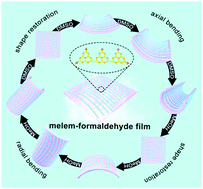Stimuli-responsive anisotropic actuation of melem-formaldehyde polymer†
Abstract
In nature, organisms control their deformation and locomotion through multi-functional synergy in response to environmental changes. Nowadays, most synthetic biomaterial systems are capable of realizing single-mode actuation movement under external triggers through biomimetic simulation, while complicated and continuous locomotion in artificial materials with multi-dimensional responsiveness remains to be explored. Here we report an anisotropic melem-formaldehyde polymer that is self-assembled from a one-dimensional (1D) chain into a two-dimensional (2D) film. The stimuli-responsive polymer film shows anisotropic responses in both radial and axial directions on contacting with different solvents (liquid or vapor) in a single material. Complex multi-dimensional motion patterns can be actuated and reversibly controlled by virtue of different interactions within the 1D line and 2D film as well as the gradients along the thickness direction. The developed architecture with tunable and programmable anisotropy is potentially applicable in soft material actuators that can operate in various environments.



 Please wait while we load your content...
Please wait while we load your content...